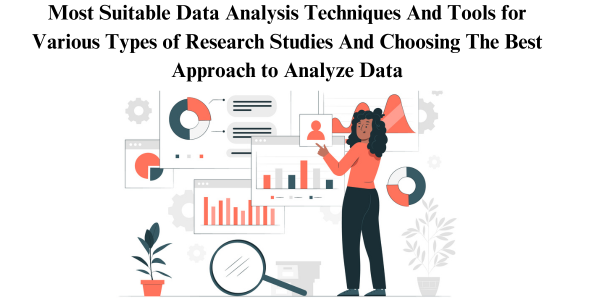Welcome to the world of research paper writing in PhD! As aspiring scholars, we understand the overwhelming journey that accompanies the pursuit of publishing your groundbreaking research in international journals. Crafting an outstanding research paper requires not only dedication and hard work but also the art of effective data presentation and analysis. In this exciting exploration, we delve into the secrets of presenting your research findings in a compelling manner, unlocking the potential to captivate readers and reviewers alike. Whether you’re a seasoned researcher seeking to refine your skills or a newcomer seeking research paper writing help, we’ve got you covered with expert tips, practical strategies, and invaluable research paper writing services to help you achieve your academic dreams.
Ensuring Clarity And Impact on Readers by Using Research Papers
Ah, the age-old question of how to wield the power of data presentation to conquer the hearts of readers and reviewers and secure that coveted spot in international journals! Fear not, fellow researchers, for we have some secrets up our sleeves to make your research paper shine like a beacon of brilliance.
First and foremost, clarity is key! Make sure to organize your data in a logical and coherent manner, guiding your readers through the treasure trove of information with ease. A well-structured research paper acts as a smooth sailing ship, carrying your readers from one point to another without leaving them lost in a sea of numbers and figures.
Now, let’s talk about reviewers. These guardians of scholarly gateways can be quite picky. To appease their discerning eyes, ensure that your data presentation is not only clear and impactful but also backed by robust methodology and statistical analysis. Show them the solid foundations upon which your research stands, and they’ll bow down to your academic prowess.
“But how can PhD Thesis help us on this epic quest?” So think of us as your reliable escorts through the perilous PhD research paper writing terrain! Our team of experienced researchers and writers knows the secret art of data presentation like the back of our hands. We’ll work side by side with you to sculpt your data into a masterpiece that mesmerizes readers and earns the admiration of reviewers.
Most Suitable Data Analysis Techniques And Tools for Various Types of Research Studies And Choosing The Best Approach to Analyze Data
First, let’s understand that there’s no one-size-fits-all approach to data analysis. Just like a masterful chef, you must choose the right ingredients and techniques to concoct a delectable dish of research findings. Depending on your research type and data characteristics, various tools and techniques await you!
Utilize statistical analysis for quantitative studies to uncover valuable insights from your data, strengthening conclusions and enhancing research validity. Now, for qualitative studies, master the art of thematic analysis and content analysis. Delve into the depths of words and meanings to extract rich insights that breathe life into your research paper and make it resonate with readers.
But wait, there’s more! In this digital age, data analysis tools have evolved into mighty wizards. Embrace the magic of software like SPSS, R, Python, or NVivo, to name a few. With their computational sorcery, they’ll crunch numbers and reveal patterns, making your research findings robust and compelling.
Now comes the crucial question: how do you choose the best approach? It’s like picking the perfect wand at Ollivanders! Assess your research objectives, data type, and analysis needs carefully. Seek the wisdom of experienced researchers or consult with mentors and peers to find the best fit.
So, fear not, dear researchers! Take the hands of PhD Thesis and embark on this exhilarating adventure with us. Together, we’ll master the art of data analysis, making your research soar to new heights and claim its rightful place in the pantheon of scholarly achievements.
Contribution of The Integration of Data Visualization Techniques in Research Paper Writing Help And The Best Practices
Picture this: you’ve collected a trove of data, but without proper visualization, it may resemble a labyrinth without a map. Fear not, for data visualization is the key that unlocks the true potential of your findings. By presenting your data in engaging charts, graphs, and infographics, you lead readers through a vivid narrative, allowing them to grasp complex concepts at a glance. These visual delights breathe life into your research, transforming it from a mere collection of numbers into a captivating story that resonates with readers.
Now, let’s unveil the best practices for incorporating these visual wonders. Similar to an artist thoughtfully selecting colours and strokes to create a masterpiece, you must conscientiously choose the appropriate visual elements to enhance the visual appeal and impact of your paper. Strike a balance between simplicity and complexity; too much clutter can confuse readers, while too little detail may obscure important insights.
“How can PhD Thesis be our guide in this mesmerising journey?” you may suddenly be wondering. Don’t worry, we have a wealth of knowledge when it comes to data visualisation. Our team of skilled researchers and designers knows the art of creating visually stunning and informative graphics that elevate your research paper’s overall quality and appeal.
Research Paper Writing Services
Imagine having a team of seasoned experts by your side, eager to understand your research inside-out and work with you to create a cohesive and compelling narrative that captivates readers from the very first word. Gone are the days of struggling to find the perfect structure or the most impactful way to present your findings. With research paper writing help, your data will be analyzed and presented in a way that showcases the true essence of your work, leaving reviewers in awe of your research prowess.
Now, let’s talk about how our company, PhD Thesis, can be your ultimate partner on this exhilarating ride. Our mission is to empower aspiring scholars like you with the tools and support necessary to conquer the world of research paper writing in PhD. With a team of brilliant minds, well-versed in various disciplines, we take pride in offering personalized assistance tailored to your specific needs. Whether you’re seeking guidance on crafting a compelling introduction, refining your methodology, or ensuring flawless citations, we’ve got you covered!
From brainstorming sessions to polishing the final draft, our research paper writing services are designed to bring out the brilliance of your research and showcase it in the most impactful way possible.
Final Thoughts
Congratulations, esteemed PhD researchers, on reaching the thrilling conclusion of our exploration into effective data presentation and analysis for research papers in international journals! Throughout this journey, we’ve learned the secrets of engaging readers and reviewers with clear data presentations. We’ve also discovered how to choose the right analysis techniques to strengthen the validity of our findings. Additionally, we’ve explored the magic of data visualization, making our research come alive for readers. Now, armed with these insights, you are prepared to write research papers like seasoned scholars. Should you ever need assistance, our company, PhD Thesis, is here to help you achieve your academic goals and publish in international journals successfully.
FAQs
1. How to choose the best paper writing service?
Choosing the best paper writing service requires considering key factors: Reputation and reviews reflect the provider’s reliability and past client satisfaction. Expertise and specialization ensure the writers’ qualification in your subject area. Originality and plagiarism-free work guarantee the authenticity of the content. Timely delivery is crucial for meeting strict deadlines. These factors collectively contribute to a reliable and effective service for your academic or professional writing needs.
2. What are the best paper writing services in 2023-2024?
Here are some of the best paper writing services for 2023-2024 based on research: EssayPro and EssayService offer experienced writers, quality papers, and customer support. PaperWriter is gaining popularity with competitive prices and diverse paper types. DoMyEssay has a reliable track record with various guarantees. WriteMyEssay.help is budget-friendly and provides high-quality papers. As for our company, PhD Thesis, we have experienced writers with PhDs, offering a money-back guarantee and free revisions. Our plagiarism checking and 24/7 customer support ensure top-quality service. With over a decade of experience, we are a reliable and trustworthy choice for assistance with PhD theses.
3. How should I go about writing a research paper?
Writing a research paper effectively involves several essential steps. Begin by understanding the assignment guidelines and requirements. Select a relevant and interesting topic that fits your area of study. Conduct thorough background research using reputable sources and take organized notes. Develop a focused thesis statement that outlines your main argument. Create a well-structured outline to guide the paper’s flow. Following these steps will lead to a well-organized and rewarding research paper.





